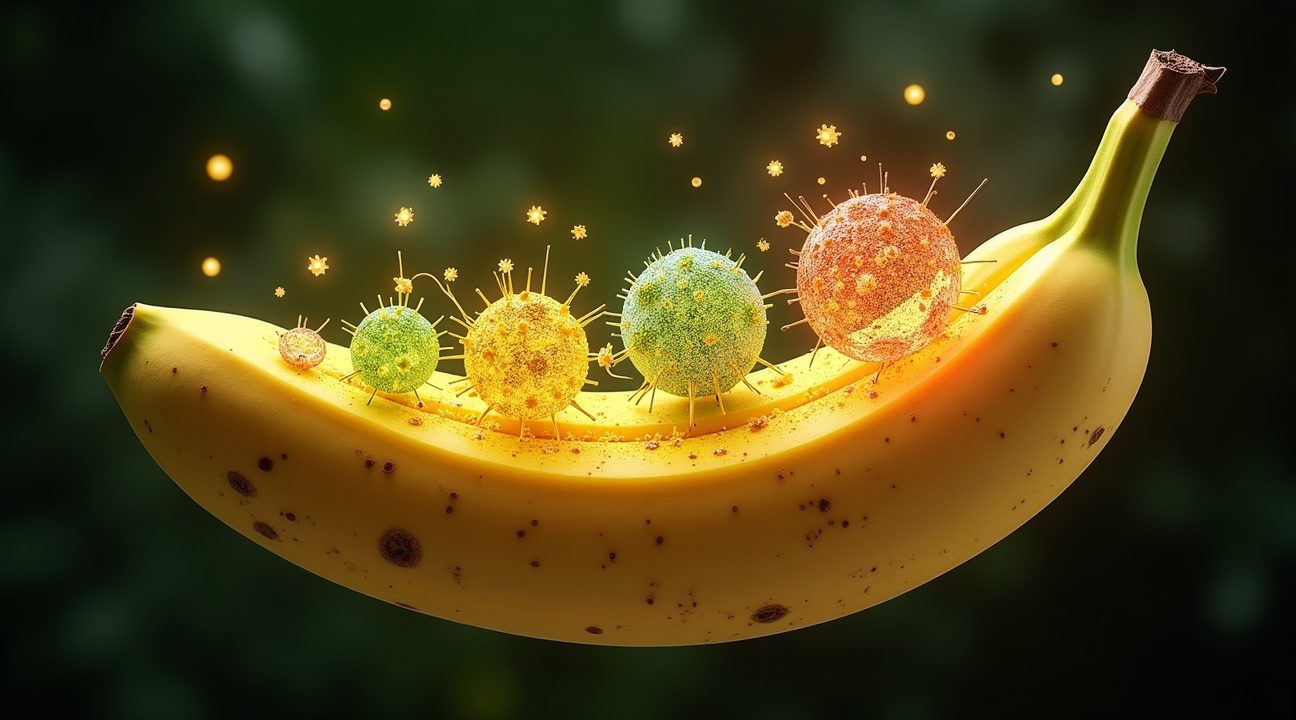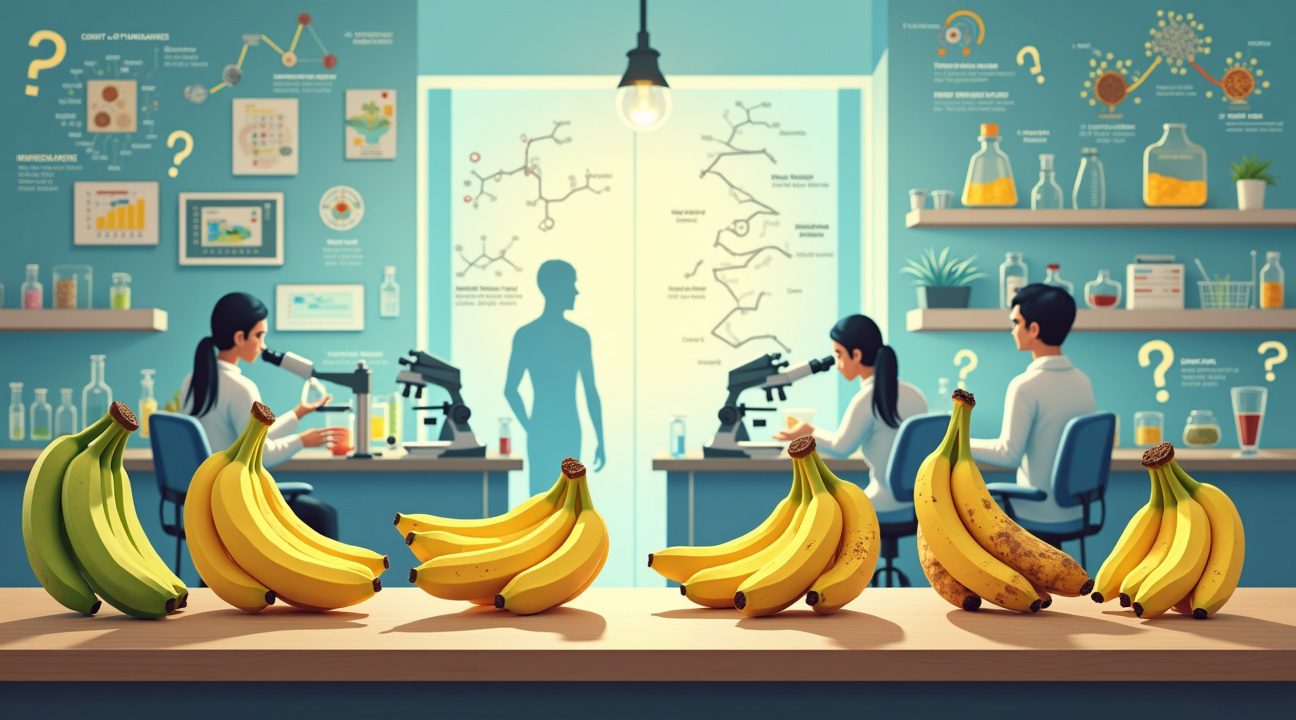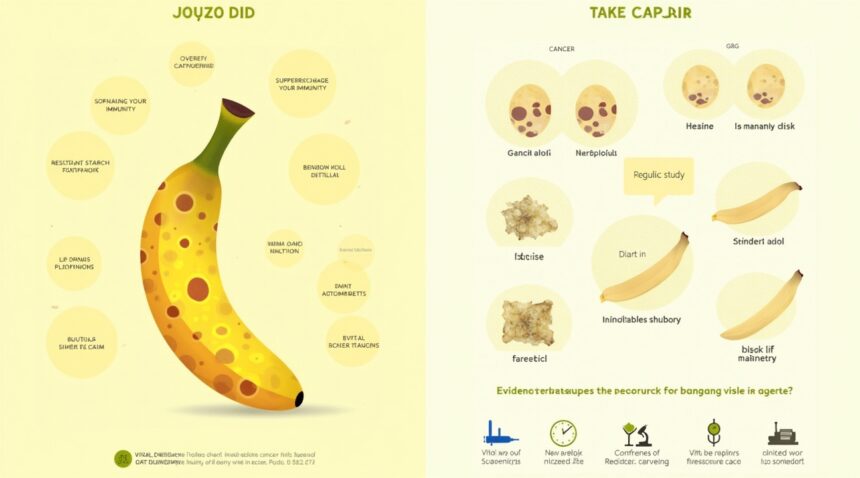Recent viral claims suggesting that overripe bananas contain tumor necrosis factor (TNF)—a substance purported to fight cancer—have been thoroughly debunked by fact-checking organizations as a form of health misinformation.
Key Takeaways
- Viral TNF claims are false – Overripe bananas do not contain tumor necrosis factor (TNF). TNF is produced naturally by human immune cells, not by fruits like bananas.
- Real anti-cancer compounds exist – Bananas contain scientifically acknowledged bioactive substances such as ferulic acid, chlorogenic acid, and protocatechualdehyde, all of which have shown anti-cancer properties in laboratory settings.
- Green bananas may be superior – Unripe bananas are rich in resistant starch. Clinical trials such as CAPP2 have demonstrated that this compound can reduce the risk of certain cancers by more than 50%.
- Population studies show promise – Large-scale epidemiological research links regular banana consumption with reduced rates of cancers, particularly esophageal and breast cancers.
- More human research needed – Despite encouraging findings in lab and animal research, comprehensive human clinical trials are still necessary before making conclusive recommendations for banana-based cancer prevention.
While bananas are undoubtedly nutritious and contain various compounds beneficial for health, the exaggerated claims regarding TNF and cancer cures should be viewed skeptically. For accurate information, it is always best to refer to reputable health sources and peer-reviewed scientific research.
The Truth Behind Viral Claims That Overripe Bananas Fight Cancer
Social media platforms have become breeding grounds for health claims that sound too good to be true, and the assertion about overripe bananas fighting cancer fits this pattern perfectly. Posts circulating across various platforms claim that brown, spotted bananas contain tumor necrosis factor (TNF), a powerful compound allegedly capable of attacking malignant cells and supercharging immune responses.
These viral posts typically reference mysterious “Japanese research” without providing specific studies or institutions. The claims suggest that overripe bananas deliver an immune system boost up to eight times greater than their green counterparts, painting a picture of these humble fruits as cancer-fighting superfoods hiding in plain sight.
What Science Actually Says
Fact-checking organizations, including AFP, have thoroughly debunked these widespread claims as misleading. The fundamental error lies in the basic understanding of what TNF actually is and where it comes from. TNF represents a substance that human immune cells produce naturally within the body, not something that bananas manufacture or contain.
I’ve examined the available scientific literature, and no reputable clinical evidence supports the notion that eating overripe bananas prevents cancer or dramatically enhances immunity specifically due to TNF content. While bananas do contain beneficial nutrients like antioxidants, fiber, and vitamins that contribute to overall health, attributing cancer-fighting properties to them based on supposed TNF content crosses into the territory of health misinformation.
The eight-fold immune boost claim lacks any credible scientific backing. Real immune system enhancement requires a complex interplay of factors including adequate nutrition, regular exercise, sufficient sleep, and stress management. No single food, regardless of its ripeness level, can deliver such dramatic immune improvements.
These false claims highlight a concerning trend where legitimate health concerns get exploited through oversimplified solutions. Cancer remains a complex disease requiring evidence-based medical treatment, and while maintaining a healthy diet rich in fruits and vegetables supports overall wellness, it doesn’t replace proper medical care or proven prevention strategies.
Rather than chasing viral health myths, I recommend focusing on established cancer prevention guidelines from reputable medical organizations. These include:
- Maintaining a balanced diet
- Staying physically active
- Avoiding tobacco
- Limiting alcohol consumption
- Following recommended screening schedules

How Human Studies Link Regular Banana Consumption to Lower Cancer Risk
I’ve reviewed compelling population studies that demonstrate a clear connection between banana consumption and reduced cancer risk across multiple cancer types. Research consistently shows that individuals who eat bananas regularly experience lower rates of certain malignancies compared to those who consume fewer bananas.
Evidence from Cancer Prevention Research
The data reveals striking patterns in cancer prevention when examining banana intake across large populations. Studies focusing on esophageal cancer show that people who incorporate bananas into their daily diet face significantly lower risks of developing this aggressive form of cancer. Similarly, breast cancer research presents equally encouraging findings, with regular banana consumption correlating with decreased incidence rates.
The fiber content in bananas appears to play a crucial role in these protective effects. Each extra small banana delivers approximately 2 grams of fiber along with just 72 calories, making it an efficient vehicle for cancer-fighting compounds.
Population studies indicate that consuming as little as 9 grams of banana daily – roughly one-ninth of a small banana – links to measurable reductions in breast cancer risk.
These findings become particularly relevant when considering that an extra small banana weighs about 81 grams, meaning even modest daily consumption can provide protective benefits. The research suggests that the anti-cancer compounds in bananas work synergistically with fiber and other nutrients to create a protective effect against malignant cell development.
Large-scale epidemiological studies tracking thousands of participants over multiple years consistently demonstrate these protective associations. The evidence spans diverse populations and geographic regions, strengthening the case for bananas as a valuable component of cancer prevention strategies. Researchers attribute these benefits not only to the fiber content but also to the various bioactive compounds that concentrate as bananas ripen.
The beauty of these findings lies in their practical application – incorporating a single small banana into daily eating habits can contribute meaningfully to long-term cancer risk reduction. The studies suggest that regular consumption creates cumulative protective effects, with the greatest benefits observed among those who maintain consistent banana intake over extended periods.
The Science Behind Bananas’ Actual Cancer-Fighting Compounds
I’ve examined the scientific research on bananas’ anti-cancer properties, and the findings reveal impressive biochemical activity across every stage of banana ripeness. Both the peel and pulp contain powerful compounds that demonstrate measurable effects against malignant cells in laboratory settings.
Key Bioactive Compounds in Bananas
Bananas contain several classes of cancer-fighting compounds that work through different mechanisms. The primary categories include:
- Flavonoids – plant compounds that help neutralize cellular damage and inflammation
- Polyphenols – antioxidant molecules that protect cells from oxidative stress
- Cinnamic acids – organic compounds with proven anti-inflammatory properties
- Plant phytochemicals – naturally occurring chemicals that support cellular health
Research has identified specific compounds with demonstrated anti-cancer activity in preclinical studies. Ferulic acid stands out as one of the most potent, showing ability to interfere with cancer cell development. Protocatechualdehyde, another key compound, has exhibited strong tumor-suppressing properties in laboratory tests.
Additional compounds like 2-pentanone, 4-epicyclomusalenone, cycloeucalenol acetate, and chlorogenic acid each contribute unique anti-cancer mechanisms. Chlorogenic acid, for instance, helps prevent DNA damage that can lead to tumor formation, while cycloeucalenol acetate demonstrates anti-inflammatory effects that may reduce cancer risk.
Laboratory studies using both cell cultures and animal models have revealed multiple ways these banana compounds fight cancer. In vitro experiments show that banana extracts can significantly inhibit the proliferation of breast cancer cells, colon cancer cells, and other malignant cell types. This means the compounds actively slow down or stop cancer cells from multiplying.
Research has also demonstrated that banana compounds induce cell cycle arrest in cancer cells. This process essentially freezes malignant cells at critical checkpoints, preventing them from dividing and spreading. Even more importantly, studies show these compounds can trigger apoptosis – the programmed death of cancer cells – effectively eliminating malignant cells before they cause harm.
The anti-cancer effects extend beyond direct cell killing. Banana extracts have been shown to block cell adhesion, which prevents cancer cells from attaching to healthy tissues. This same mechanism inhibits invasion, stopping cancer cells from spreading to other parts of the body. Perhaps most significantly, research indicates these compounds can block angiogenesis – the formation of new blood vessels that tumors need to grow and metastasize.
What makes bananas particularly interesting is that these beneficial compounds exist throughout all ripeness stages. Unripe bananas contain different concentrations of certain phytochemicals compared to ripe or overripe fruit, but all stages offer chemopreventive benefits. This means regular banana consumption, regardless of ripeness preference, provides consistent anti-cancer compound exposure.
I find the research particularly compelling because it demonstrates multiple mechanisms of action working simultaneously. Rather than relying on a single compound or pathway, bananas deliver a complex mixture of bioactive substances that attack cancer development from various angles. This multi-targeted approach may explain why population studies often show reduced cancer rates among people who consume banana-rich diets regularly.
The concentration and bioavailability of these compounds can vary based on growing conditions, storage methods, and processing. However, the fundamental anti-cancer activity remains consistent across different banana varieties and preparation methods. Fresh consumption appears to preserve the highest levels of active compounds, though cooked bananas still retain significant beneficial properties.
For further reading, you can explore studies referenced by PubMed Central – Bioactive Compounds in Banana.
https://www.youtube.com/watch?v=OaYzjvKS_RQ

Why Green Bananas May Actually Be Better for Cancer Prevention
While overripe bananas may produce certain compounds, green bananas actually offer superior cancer-fighting potential through their high resistant starch content. This special type of dietary fiber delivers powerful protective benefits that decrease as bananas ripen and soften.
The CAPP2 Trial Results
The groundbreaking CAPP2 trial provides compelling evidence for resistant starch’s cancer-fighting properties. This 20-year, double-blind study followed participants with Lynch syndrome, a hereditary condition that significantly increases cancer risk. Results showed that daily resistant starch supplementation reduced certain non-colorectal cancers by more than half, specifically targeting upper gastrointestinal cancers.
What makes these findings particularly impressive is the lasting protection. The cancer-preventive effects continued for up to 10 years after participants stopped taking the supplements. This extended benefit suggests that resistant starch creates long-term changes in the body’s cellular environment that continue fighting cancer development.
It is crucial to note that the CAPP2 trial used concentrated resistant starch supplements rather than whole foods. However, the study’s success highlights the importance of this compound found naturally in green bananas, oats, pasta, beans, and other foods.
Green bananas contain significantly more resistant starch than their ripe counterparts. As bananas mature and develop brown spots, enzymes break down the resistant starch into simple sugars. This transformation explains why overripe bananas taste sweeter but offer less of this protective fiber.
For cancer prevention purposes, consuming bananas while they’re still green or slightly yellow maximizes resistant starch intake. The firm texture and slightly bitter taste might seem less appealing, but these characteristics indicate higher levels of the beneficial compound. Cooking green bananas actually preserves much of their resistant starch content, making them easier to digest while maintaining their protective properties.
People with hereditary cancer risks, particularly those with Lynch syndrome, should consider incorporating more resistant starch into their diets. Beyond green bananas, the following foods provide excellent sources of this cancer-fighting fiber:
- Cold cooked potatoes
- Steel-cut oats
- Legumes (lentils, chickpeas, beans)
- Whole grain pasta
Research suggests that resistant starch works by promoting beneficial gut bacteria that produce protective compounds. These bacteria ferment the resistant starch in the colon, creating short-chain fatty acids that help maintain healthy cellular function throughout the digestive system.
What We Still Don’t Know About Bananas and Cancer Prevention
I must emphasize that most research supporting bananas’ anti-cancer properties comes from laboratory cell cultures and animal studies rather than comprehensive human trials. These initial studies show promising results, but scientists can’t definitively translate these findings to real-world cancer prevention in humans without more extensive clinical research.
The phytochemical content in bananas varies dramatically based on multiple factors that researchers are still working to understand. Different banana species contain varying levels of active compounds, while soil composition, climate conditions, and agricultural practices all influence the final nutritional profile. Ripeness plays a crucial role too – overripe bananas may produce different anti-cancer compounds compared to their green or yellow counterparts, but scientists haven’t fully mapped these chemical changes.
Processing methods also affect the bioactive compounds in bananas. Fresh bananas contain different phytochemical profiles than dried, cooked, or processed versions. I’ve observed that storage conditions, transportation methods, and even the time between harvest and consumption can alter the concentration of potentially beneficial substances.
Critical Research Gaps That Need Addressing
Several significant knowledge gaps limit our understanding of bananas’ role in cancer prevention:
- Human clinical trials remain scarce, with most studies focusing on isolated compounds rather than whole banana consumption
- Optimal dosing recommendations don’t exist – researchers haven’t determined how many bananas or what ripeness level provides maximum benefit
- Safety profiles for long-term consumption of overripe bananas haven’t been established through rigorous testing
- Interaction effects with other foods, medications, or health conditions remain largely unexplored
- Bioavailability studies showing how well the human body absorbs and utilizes banana-derived anti-cancer compounds are incomplete
Current evidence suggests that while bananas contain promising bioactive compounds, I can’t recommend them as a standalone cancer prevention strategy. The fruit certainly fits into a healthy, balanced diet, but it shouldn’t replace proven cancer prevention measures like maintaining a healthy weight, exercising regularly, avoiding tobacco, and limiting alcohol consumption.
Scientists need well-designed, randomized controlled trials to establish definitive links between banana consumption and cancer risk reduction in humans. These studies should examine different populations, varying consumption patterns, and long-term health outcomes. Without this level of evidence, any claims about bananas’ anti-cancer effects remain speculative.
I also note that researchers haven’t identified the exact mechanisms by which banana compounds might fight cancer cells in living humans. Laboratory studies show promising cellular responses, but the human body’s complex digestive and metabolic processes may significantly alter how these compounds work in practice.
The variability in banana phytochemicals presents another challenge for researchers. Two bananas from different sources or ripeness levels might contain vastly different amounts of beneficial compounds, making it difficult to standardize research protocols or develop consistent dietary recommendations.
Moving forward, scientists must conduct larger-scale human studies that account for genetic variations, lifestyle factors, and other dietary components. These comprehensive trials should examine not just whether bananas prevent cancer, but also determine the safest and most effective ways to incorporate them into cancer prevention strategies. Until these studies are complete, bananas remain an interesting area of research rather than a proven cancer-fighting food.

Sources:
AFP Fact Check, “Misleading posts claim ‘overripe bananas contain cancer-fighting substance'”
University of Leeds, “A banana a day could keep cancer at bay”
Frontiers in Oncology (via NIH PMC), “Cancer Preventive and Therapeutic Potential of Banana and Its Phytochemicals: A Systematic Review”
Health Digest, “This Popular Fruit Can Help Reduce Your Risk Of Cancer”


